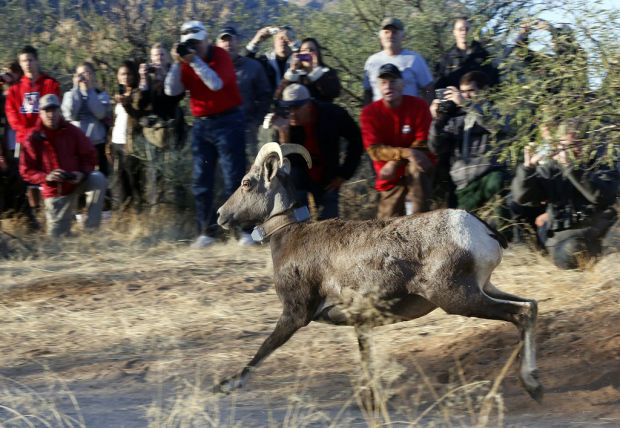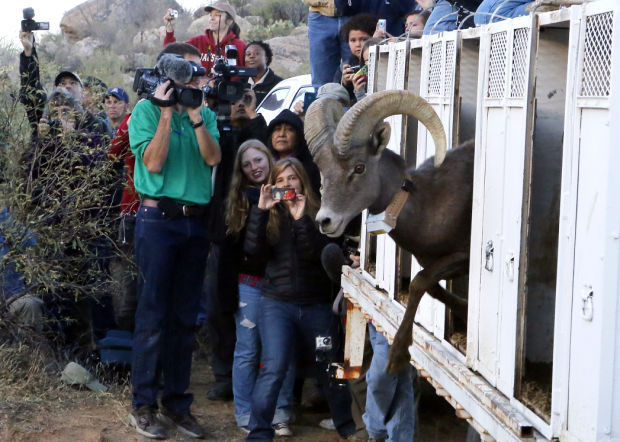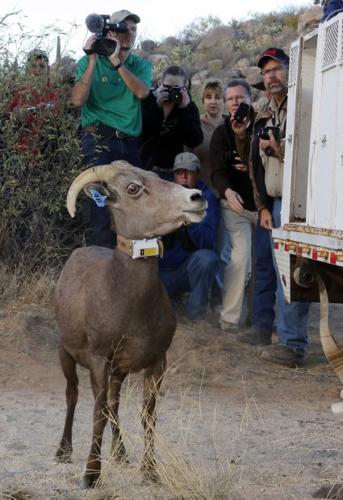Bighorn sheep are roaming wild in the Catalina Mountains once more.
Thirty-one of the fleet, agile animals — captured in rugged mountains near Yuma over the weekend — were released early Monday at Catalina State Park north of Tucson.
The 24 ewes, six rams and one lamb leapt out of a transport trailer when doors were opened and made a bounding beeline for craggy Pusch Ridge.
State wildlife officers “transplanted” the animals as a first step in an effort to rebuild a bighorn herd that died out in the Catalinas in the 1990s.
“So far, it’s looking good,” said Raul Vega, regional supervisor for the Arizona Game and Fish Department, minutes after the bighorns took to the hills. “There were no fatalities” or serious injuries in the process of capturing and releasing the animals.
Plans call for transplanting 30 more sheep to the area next year and another 30 the following year with hopes of building a herd of about 100 animals.
“SECONDS OF EXCITEMENT”
Game and Fish Department officers — along with the U.S. Forest Service and an advisory group from conservation and wildlife organizations — spent more than a year evaluating the transplant concept and working out details for carrying it out.
Department spokesman Mark Hart summed up the project goal this way: “The overall objective is to restore a healthy, viable and self-sustaining bighorn sheep population that coexists in natural balance with a healthy native predator population in a naturally functioning ecosystem.”
The overall cost estimate for the project: $600,000 over the next three years. Public and private fundraising efforts are underway to secure funding, Hart said.
Compared with the two-day sheep-capture operation near Yuma, where wildlife officers used a net-gun fired from a helicopter to snare sheep, the release on Monday seemed to be over in a heartbeat.
“Welcome to wildlife management,” Joe Sacco, field supervisor for the Game and Fish Department, said after the release. “It’s years of planning punctuated by seconds of excitement.”
NOT ALL AGREE
Numerous residents of Southern Arizona have contacted the Arizona Daily Star to voice objections to the reintroduction — many calling it a “death sentence” for sheep seeking a foothold in an area where the previous herd died out. Some have expressed their misgivings in public meetings on the topic.
Wildlife officers and project supporters at Monday’s release voiced optimism. But they acknowledged that it will take time to learn how the bighorns will adapt to their new home — an adaptation that could be hindered by urban encroachment, predation by mountain lions and human recreation activities.
“The previous herd thrived for years and years and years,” said J.W. Harris, chairman of the Arizona Game and Fish Commission. “Fire suppression, drought, disease, the presence of humans and other factors could have brought the demise of that herd.”
Key factors have changed, however, said Harris and others.
One is that fires have been allowed to burn naturally where possible in the sheep habitat in recent years — removing dense vegetation that provided cover for mountain lions stalking bighorns in earlier times when fires were suppressed.
Another factor: Dogs, which have a negative impact on sheep breeding and survival, are now banned from the habitat, and the Forest Service has limited off-trail travel during the January-to-April lambing season.
Also important, project supporters say, is that all of the released bighorns except the lamb, which is still growing, are fitted with Global Positioning System collars. Signals from the collars will allow wildlife officers to monitor sheep movements and learn of sheep deaths.
If it’s determined that one or more mountain lions are preying regularly on bighorns, efforts would be made to kill those lions. That’s another part of the plan that has drawn criticism from some members of the public.
WILL HERD BE HUNTED?
A spokesman for the Arizona Desert Bighorn Sheep Society, which is a member of the advisory group and a financial contributor to the project, said hunting of the species in the Catalinas could be in the future — but not the immediate future.
“If this becomes a viable, self-sustaining herd, it would be at least 10 years before there would be hunting,” said Joe Sheehey, a past president of the society.






